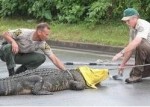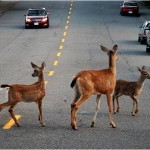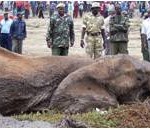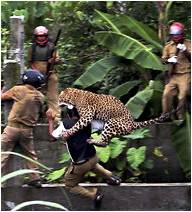 To most of us, looking out our window and seeing wildlife up close would be a dream come true. However, to those people who actually share space with magnificent wild creatures on a daily basis the dream can quickly turn into a nightmare. Human-wildlife conflicts are continuing to increase globally at an alarming rate.
To most of us, looking out our window and seeing wildlife up close would be a dream come true. However, to those people who actually share space with magnificent wild creatures on a daily basis the dream can quickly turn into a nightmare. Human-wildlife conflicts are continuing to increase globally at an alarming rate.  Some argue that wildlife populations are growing, causing animals to crossover safe boarders of national parks and wildlife refuge areas into urban land inhabited by humans. In contrast, human population growth is at an all time high; humans are encroaching into areas set aside as safe havens for wildlife. So who is to blame?
Some argue that wildlife populations are growing, causing animals to crossover safe boarders of national parks and wildlife refuge areas into urban land inhabited by humans. In contrast, human population growth is at an all time high; humans are encroaching into areas set aside as safe havens for wildlife. So who is to blame?
I don’t think it is as easy as assigning blame to a guilty party. Every creature, be it human or elephant, has the right to  live. The unfortunate reality is that the planet is running out of space. Wild habitat is being fragmented due to the dispersion of people, agriculture, deforestation, etc., causing small “islands” of land to form restricting animal migration and interactions. When resources are pushed to the limit, wildlife migrates outside of these “islands” to find other similar areas. It is on migratory paths that the human-wildlife conflict occurs. Currently, we are overusing our fertile agricultural lands to produce more food than ever before, and cutting down vital forests to build homes, additional places to grow crops and rear livestock. Furthermore, land overuse and deforestation facilitates erosion and water run-off during and after heavy rains that lead to the increase of silt in water ways that suffocate aquatic plant and animal life.
live. The unfortunate reality is that the planet is running out of space. Wild habitat is being fragmented due to the dispersion of people, agriculture, deforestation, etc., causing small “islands” of land to form restricting animal migration and interactions. When resources are pushed to the limit, wildlife migrates outside of these “islands” to find other similar areas. It is on migratory paths that the human-wildlife conflict occurs. Currently, we are overusing our fertile agricultural lands to produce more food than ever before, and cutting down vital forests to build homes, additional places to grow crops and rear livestock. Furthermore, land overuse and deforestation facilitates erosion and water run-off during and after heavy rains that lead to the increase of silt in water ways that suffocate aquatic plant and animal life.
Every year thousands of wild animals are dying due to conflicts with humans. Any individual animal posing an immediate threat to human life, personal property, or livelihood (i.e., crop raiders) are killed. Moreover, hundreds of human fatalities also occur when people are attempting to deter animals from destroying crops or homes, or when protecting their families. Although not simple, I firmly believe that a solution in attainable.
personal property, or livelihood (i.e., crop raiders) are killed. Moreover, hundreds of human fatalities also occur when people are attempting to deter animals from destroying crops or homes, or when protecting their families. Although not simple, I firmly believe that a solution in attainable.
 In 2011, as natural disasters such as drought, tsunamis, and severe flooding stress what little resources there are left, reports on human-wildlife conflicts are almost constantly dominating international news. In June, two juvenile elephants ran out of control in Mysore, India killing one man and two cows. Wildlife officials blamed unregulated expansion of farm lands and vehicles through elephant corridors as the main reason animals are entering towns. A similar story in Thailand regarding two male elephants at Khao Sok National Park caused the death of one tourist and severe injury to another. African elephants are under similar strain as human settlements along migratory corridors have spread dramatically despite government regulation. Elephants, like other animals, use the same migratory routes annually. Furthermore, in the Maasai Mara National Park, Kenya, the park continues to get smaller as elephant population increases within protected areas. Something has got to give.
In 2011, as natural disasters such as drought, tsunamis, and severe flooding stress what little resources there are left, reports on human-wildlife conflicts are almost constantly dominating international news. In June, two juvenile elephants ran out of control in Mysore, India killing one man and two cows. Wildlife officials blamed unregulated expansion of farm lands and vehicles through elephant corridors as the main reason animals are entering towns. A similar story in Thailand regarding two male elephants at Khao Sok National Park caused the death of one tourist and severe injury to another. African elephants are under similar strain as human settlements along migratory corridors have spread dramatically despite government regulation. Elephants, like other animals, use the same migratory routes annually. Furthermore, in the Maasai Mara National Park, Kenya, the park continues to get smaller as elephant population increases within protected areas. Something has got to give.
Recently in the news a leopard was destroyed at Prakash Nagar village in West Bengal, India. The leopard wondered out of the nearby wooded area that is slowly becoming part of the urban landscape and was met with hostility from local people. It was reported that villagers actively pursued the animal hitting it with rocks and sticks in an effort to chase it back into the forest. The result…11 people where mauled and the leopard was killed. Big cat experts including Samir Sinha, head of Traffic India, a division of the World Wildlife Fund India, agree that most human injuries from cats can be avoided staying out of the animals path and by no means chase or harass the already stressed creature. The most unfortunate part of this story is that this was the fourth leopard attack in India for the month of July alone.
that is slowly becoming part of the urban landscape and was met with hostility from local people. It was reported that villagers actively pursued the animal hitting it with rocks and sticks in an effort to chase it back into the forest. The result…11 people where mauled and the leopard was killed. Big cat experts including Samir Sinha, head of Traffic India, a division of the World Wildlife Fund India, agree that most human injuries from cats can be avoided staying out of the animals path and by no means chase or harass the already stressed creature. The most unfortunate part of this story is that this was the fourth leopard attack in India for the month of July alone.
The reality is that I could sit for hours, perhaps even days, and list all of the recent incidences of human-wildlife conflict  that have resulted in injury or death to one or the other party. An important side note is that human-wildlife conflicts happen in every country, on every continent, regardless of environmental conditions. I think by now, all stakeholders are well aware that there is a huge problem. Although awareness is a key component in this equation, a more important factor is resolution. So, how do we resolve the frequency of human-wildlife conflicts?
that have resulted in injury or death to one or the other party. An important side note is that human-wildlife conflicts happen in every country, on every continent, regardless of environmental conditions. I think by now, all stakeholders are well aware that there is a huge problem. Although awareness is a key component in this equation, a more important factor is resolution. So, how do we resolve the frequency of human-wildlife conflicts?
Lucy King, working with Save the Elephants and student of the amazing Dr. Ian Douglas-Hamilton, has recently published data regarding a possible deterrent to elephants traveling too close to human areas. Her solution is sweet and simple; one could say even bee-utiful. Yes, you probably have guessed it; Lucy is using honey bees to keep elephants away from specific areas. Elephants can not only smell the presence of the hive via the honey comb, but they can hear the buzzing. It is the fear of the potential stings that cause the elephant to be cautious of the area, thus deterring the elephants. This not only works to keep elephants out, but also acts as a means of funding for communities and families by harvesting honey. This could also be used together with chili pepper paste and spray. You can read more about Dr. Lucy King and her research at: http://www.elephantsandbees.com/Lucy_King/Welcome.html
cautious of the area, thus deterring the elephants. This not only works to keep elephants out, but also acts as a means of funding for communities and families by harvesting honey. This could also be used together with chili pepper paste and spray. You can read more about Dr. Lucy King and her research at: http://www.elephantsandbees.com/Lucy_King/Welcome.html
One thing that is certain is that resolution of human-wildlife conflicts is not something that will happen overnight, and it is going to take a global group effort. Innovative ideas and education will be key in reducing conflicts and empowering those people living in conflict hotspots to better prepare and prevent one-on-one interactions. What would you do to help?